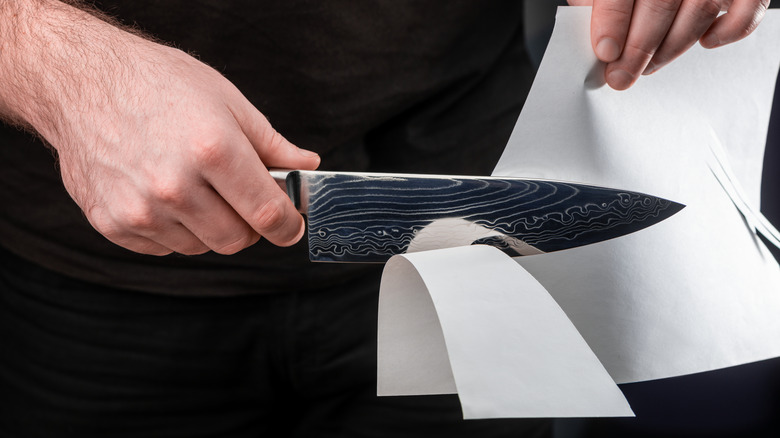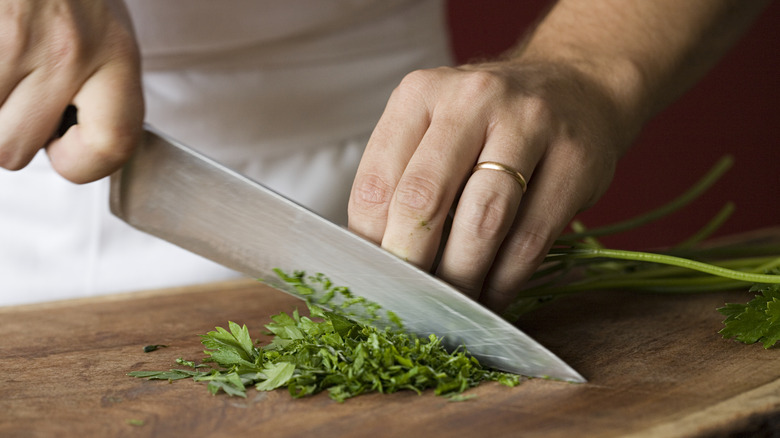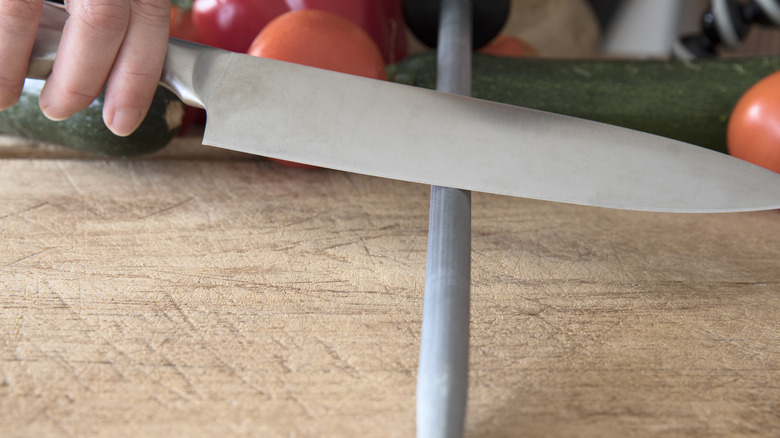Why Chopping Ingredients With Dull Knives Is Actually More Dangerous For You
Chopping up ingredients for your recipe of choice seems like the easiest part of the process. You may need carrots, onions, celery, some beef, rice, and a handful of spices, and what's so hard about that? Nothing at all, until you whip out your old, beaten up kitchen knife and attempt to turn a bulbous onion into a ¼-inch dice. That's the turning point at which most home chefs hang their apron up and declare, "Cooking is too hard, I give up!" and open that delivery app just one last time (as the weekly promise seems to go).
There are two things to keep in mind when trying to turn that bulbous, or whatever-shaped, vegetable you're trying to wrangle on your cutting board into the perfect, edible bite: What shape you want it to be, and how can you work with it while staying in control to get it there. But guess what? Those two things will get you nowhere if you aren't using the most important tool at your disposal — a sharp knife. Not only is a sharp knife going to make your life in the kitchen much easier, it's actually also much safer than a dull knife. That control you want of your knife — we'll it's out the window if it's dull. On top of that, it's also dangerous to work with a dull knife.
A dull knife requires more pressure and force
The danger in a dull knife comes down to one thing: pressure. A dull knife won't grip the food as well as a sharp knife, requiring you to press down harder as you make the chopping motion. The gently rocking movement required to slice and dice becomes a forceful press down. It doesn't really make a difference if the ingredient is hard or soft.
Imagine trying to chop basil with a plastic takeout knife — the chopping becomes more of a sawing. Or envision trying to cut a pumpkin with one — you could train in the gym with weights for a year and still not be able to make much progress. Now, picture a sharp knife gliding through a piece of paper, versus what that would look like with a dull knife. You get the point.
The danger enters once you do make a dent in that pumpkin or basil. Once the knife breaks through, your stroke is still finishing with intense pressure and force, leading the way to slips and loss of control. Between the lack of grip and the force and pressure required, a nearby finger can easily become an object in the path of your chopping destruction. In addition, the cut from a dull knife will probably hurt more as it tears the skin in lieu of a clean slice.
How to sharpen your knife (and keep it that way)
So if dull knives are dangerous and keeping your blade sharp is key to kitchen success, then what's the best way for the home cook to ensure that sharp slice? If you're a professional cook and hitting that cutting board hours on end per day, by all means invest in a good whetstone (or sharpening stone) and learn how to properly sharpen your knives and keep that edge fine-tuned. The rest of us can get away with a good sharpening two or three times a year by taking our knives into a professional sharpener who knows the correct angles and proper care.
That steel rod that comes with your countertop knife set is actually not going to sharpen — its job is to hone. The edge of the blade has microscopic burrs that, when sharp, stand up straight. With use, the burrs bend either left and right. Running the blade against the honing rod will bring them back into a straight formation and keep you slicing and dicing with a clean edge in between sharpenings. Not only is a sharp knife safer, it makes chopping a heck of a lot easier on you.


